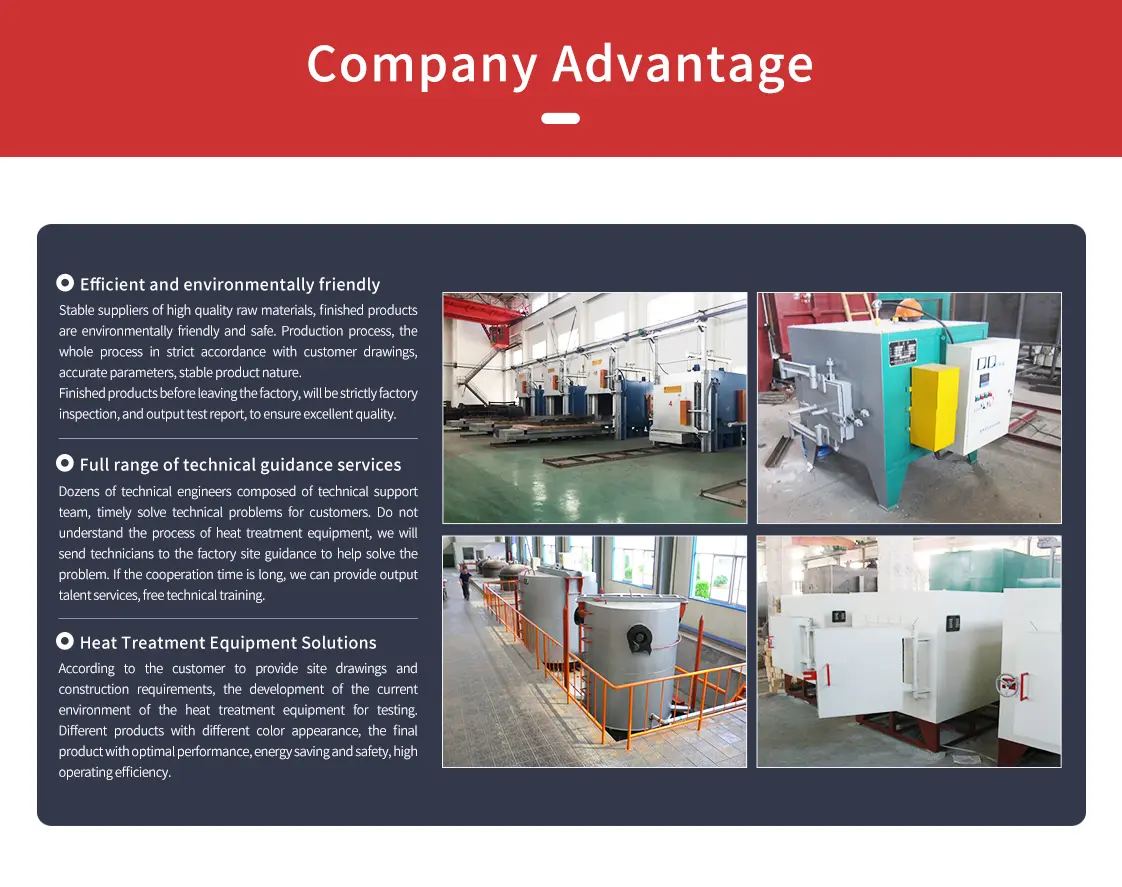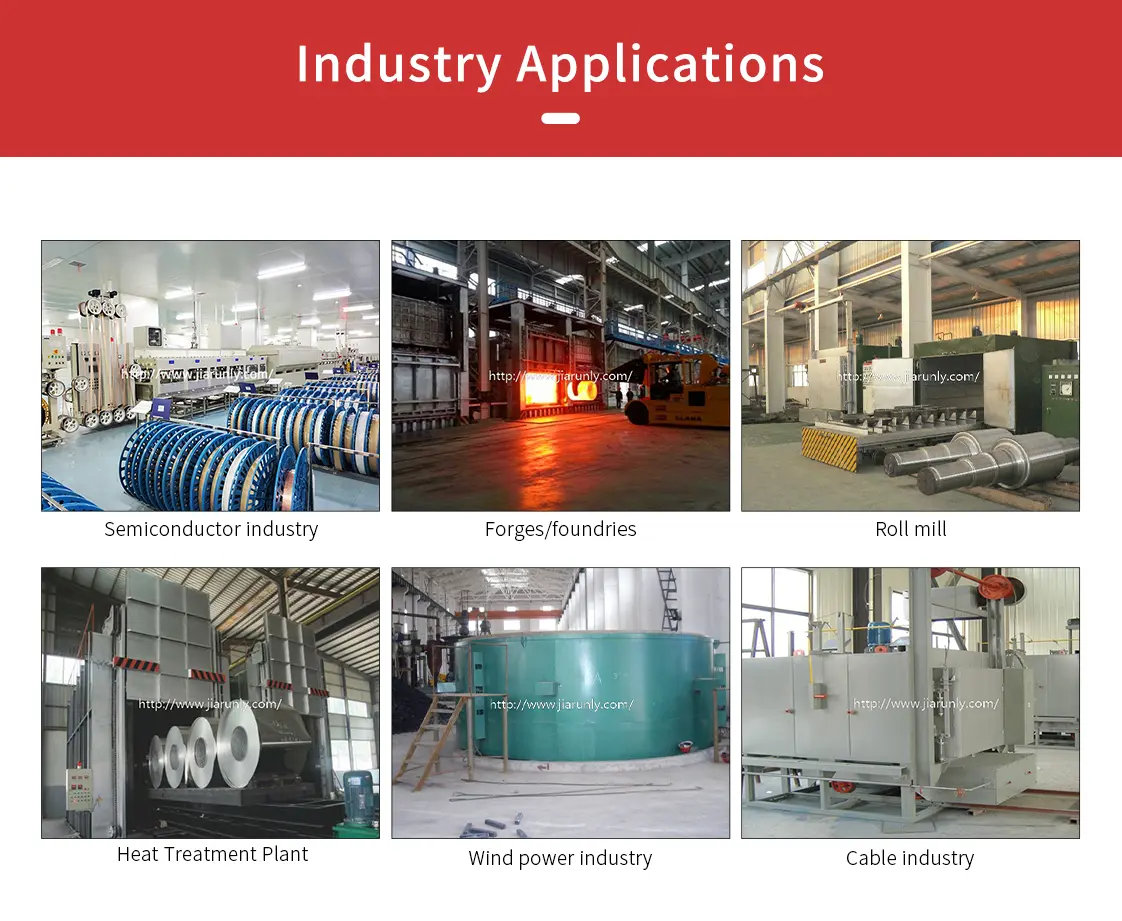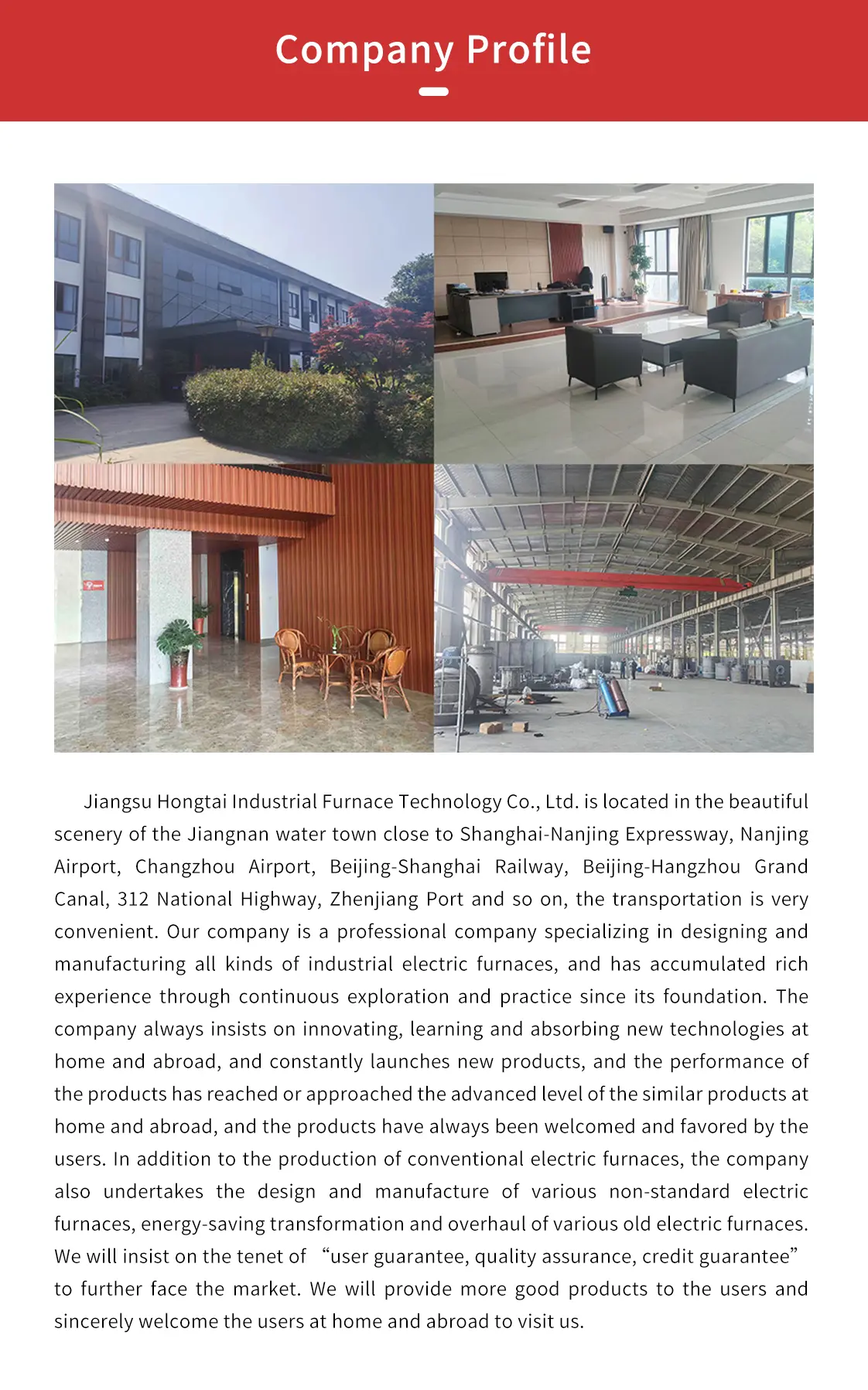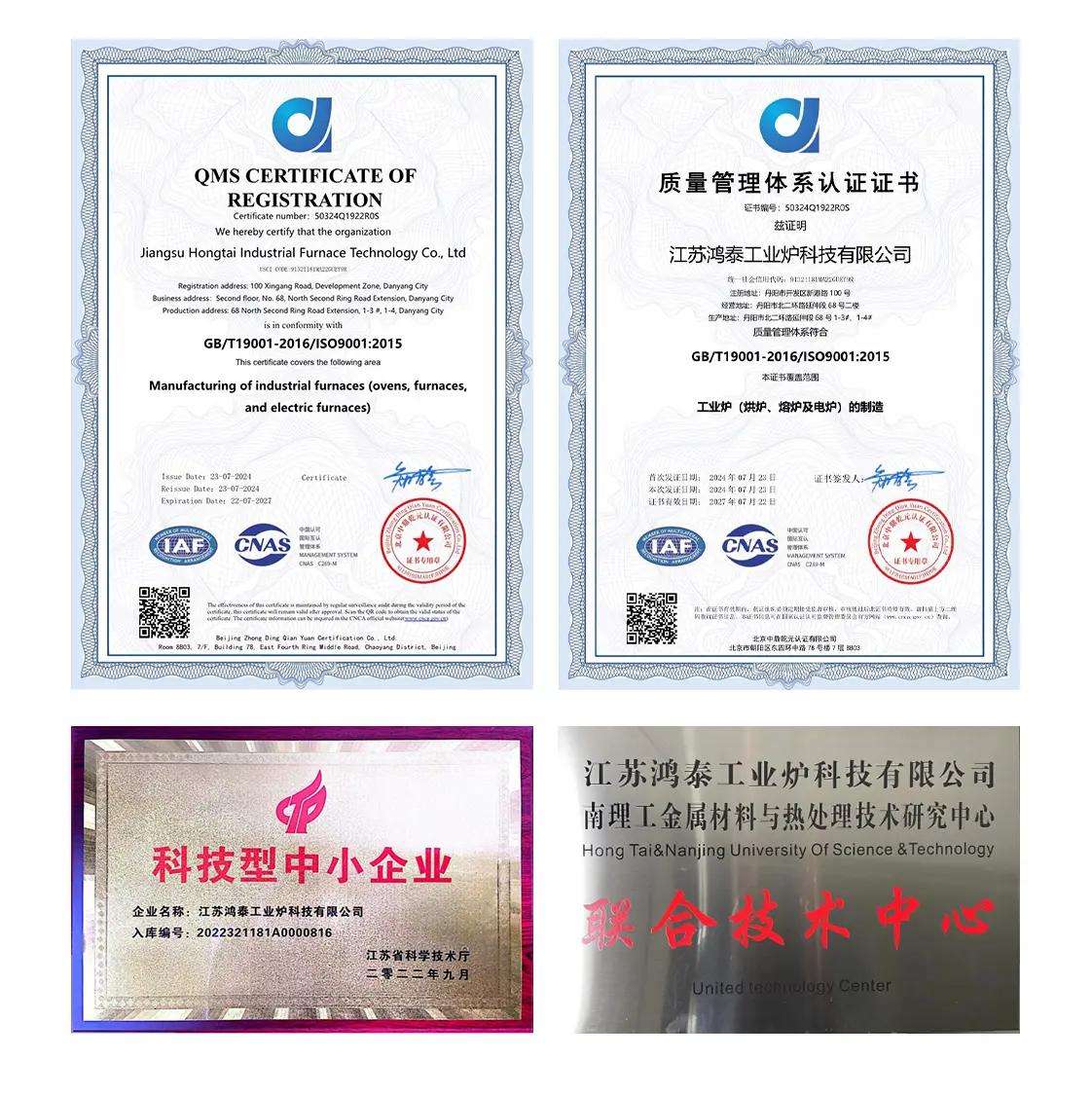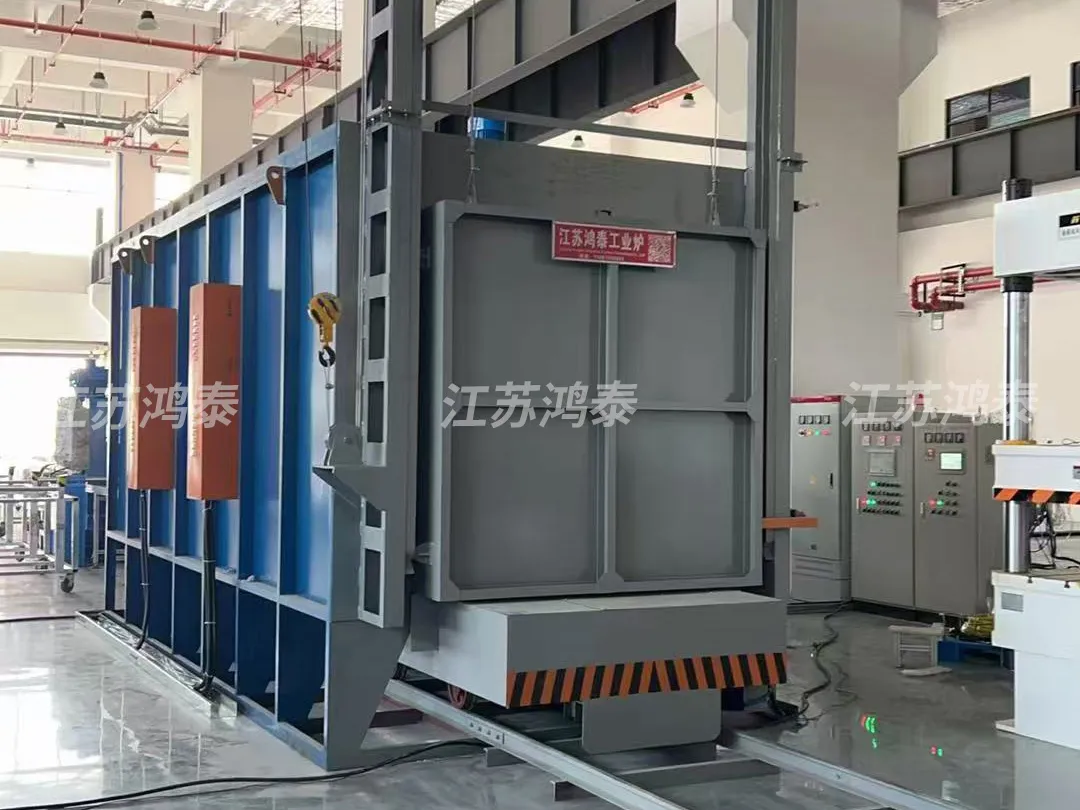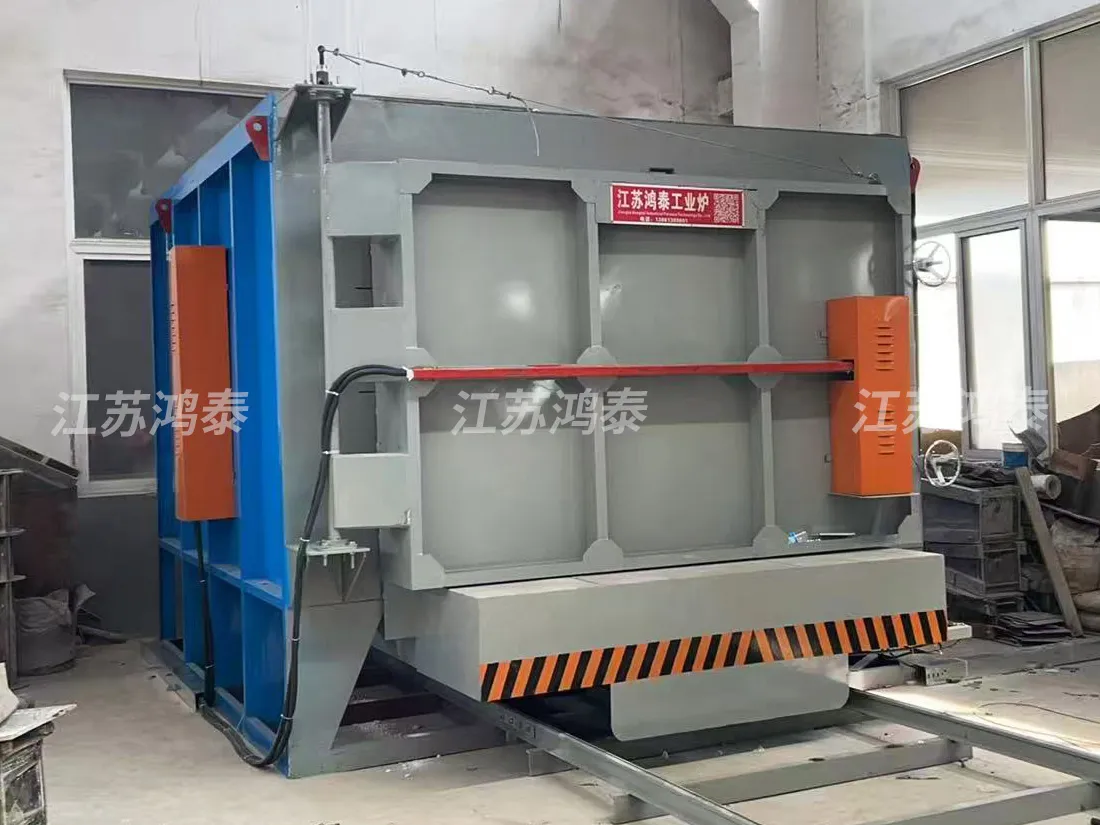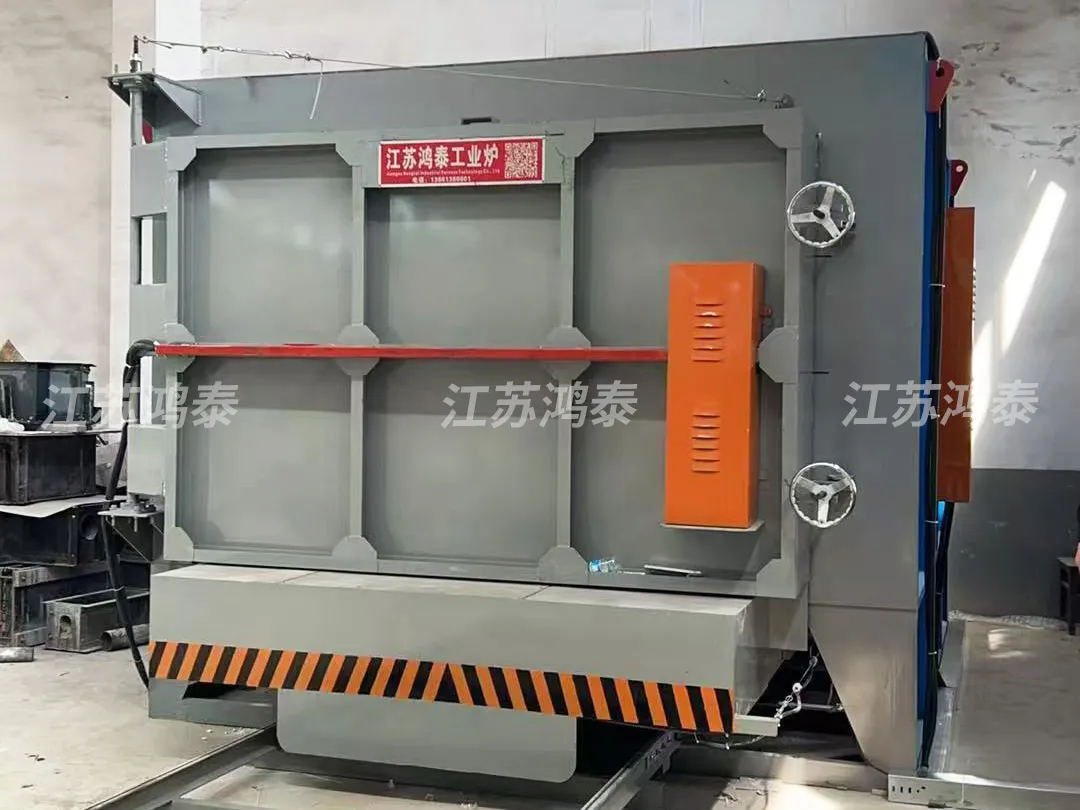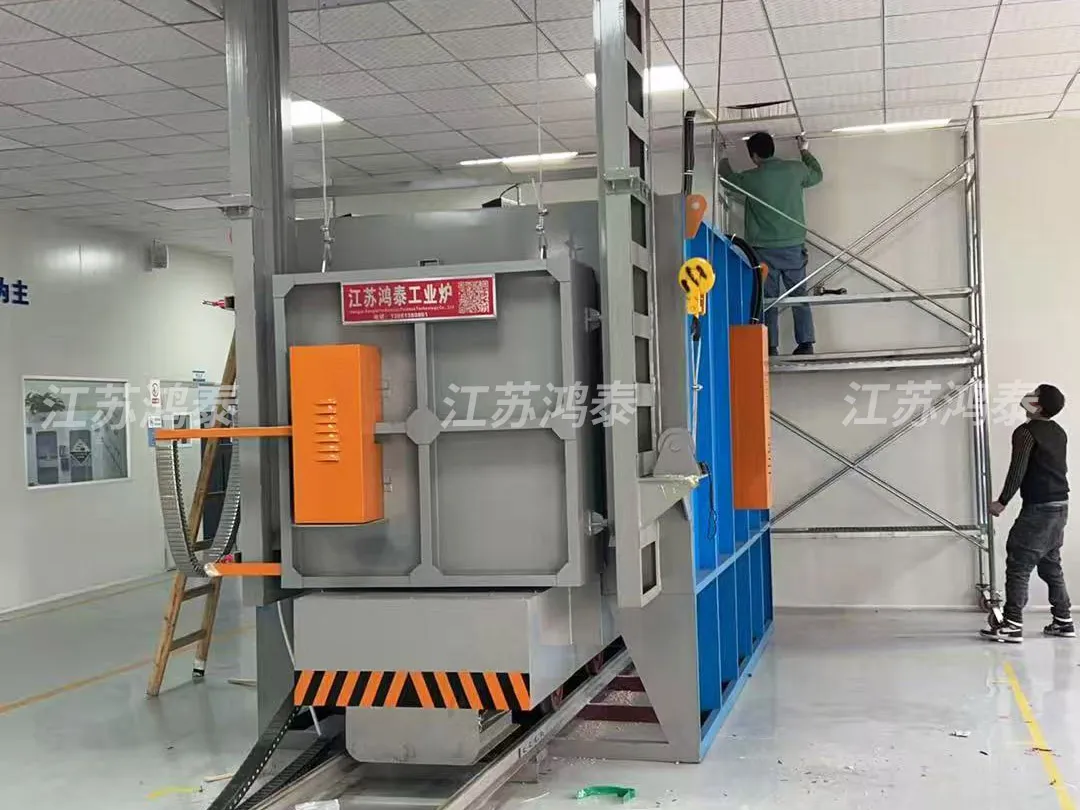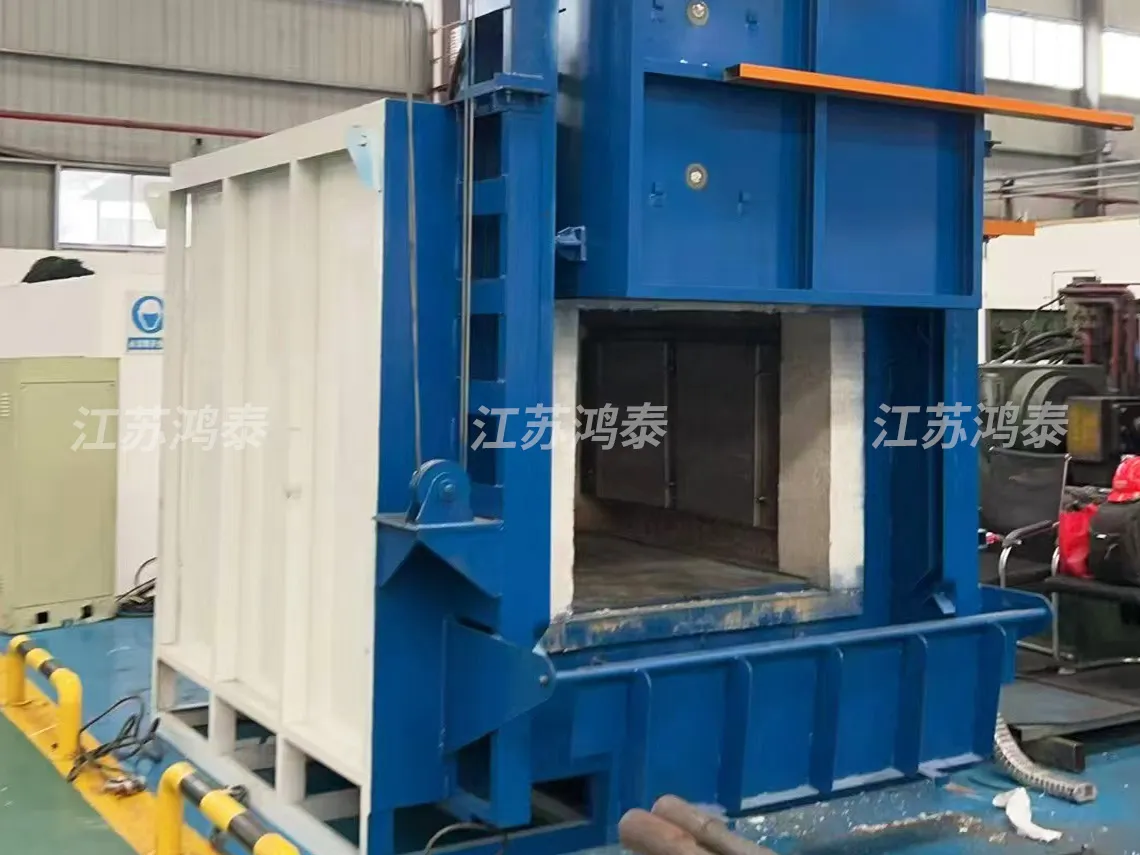- Vacuum furnace & oven
- Annealing Furnace & Oven
- Tempering furnace & oven
-
Carburizing furnace & Ovens
-
Bell Type Furnace
-
Pit Type Furnace & Well Type Furnace
-
Box Furnace & Chamber Furnace
-
Car Bottom Furnace & Bogie Hearth Furnace
-
Nitriding furnace & Ovens
-
Melting furnace & Ovens
- Quenching furnace & Ovens
-
Rapid quenching furnace & Ovens
- Forging furnace & Ovens
- Bright heat treatment furnace & Ovens
Bogie quenching furnace & Ovens
Heat treatment furnace manufacturer,Jiangsu Hongtai Industrial Furnace Technology Co., Ltd
Cart quenching furnace is a cycle operation type resistance furnace, mainly for mold steel, hardware mold, casting parts, forging parts and other metal quenching, annealing, normalizing treatment can also be used as a sintering furnace.
Bogie Quenching Furnace & Ovens
Heavy-Duty Quenching Solutions for Large and Heavy Components with Precision Control
Product Introduction
Our Bogie Quenching Furnaces & Ovens are robust and high-capacity heat treatment systems specifically engineered for the rapid and controlled cooling of large, heavy, and irregularly shaped metal components. These furnaces are crucial for achieving optimal metallurgical properties such as hardness, strength, and toughness after high-temperature processes like hardening, carburizing, or carbonitriding. The bogie (or car-bottom) design facilitates easy loading and unloading of substantial loads, making them ideal for industries handling large forgings, castings, or fabricated structures. We offer solutions compatible with various quenching media, including oil, water, polymer, and high-pressure gas, ensuring precise control over cooling rates to minimize distortion and cracking while maximizing material performance.
Core Advantages for Large-Scale Quenching
- High Load Capacity: Designed to handle large and heavy components, making them suitable for demanding industrial applications.
- Easy Loading & Unloading: Bogie (car-bottom) design allows for convenient and safe loading/unloading of heavy workpieces, improving operational efficiency.
- Precise Cooling Control: Advanced systems ensure accurate regulation of cooling rates, critical for achieving desired metallurgical properties and minimizing distortion.
- Versatile Quenching Media: Compatible with various quenching media including oil, water, polymer, and high-pressure gas, offering flexibility for different materials and processes.
- Uniform Quenching: Optimized circulation systems ensure uniform contact between the quenching medium and the workpiece, leading to consistent hardness throughout large loads.
- Robust & Durable Construction: Built with heavy-duty materials to withstand the demanding conditions of large-scale quenching operations and ensure long-term reliability.
- Automated & Safe Operation: Integrated PLC control with comprehensive safety interlocks, real-time monitoring, and data logging for reliable and secure operation.
Technical Specifications
| Parameter | Unit | Range/Value | Notes |
|---|---|---|---|
| Maximum Working Temperature | °C | Up to 1300 (for heating prior to quench) | Quenching temperature depends on material |
| Quenching Medium | - | Oil, Water, Polymer, High-Pressure Gas (N2, Ar) | Selectable based on material and desired properties |
| Quenching Tank Capacity | Liters | Customizable, Large Capacity | Designed for substantial loads |
| Rated Power | KW | Varies, High Power | For heating and circulation systems |
| Working Chamber (W×H×L) | mm | Customizable, Large Dimensions | Designed for large and heavy components |
| Temperature Uniformity (Heating) | °C | ±5 (typical) | Ensures consistent initial state for quenching |
| Control Accuracy | °C | ±1 | Advanced PID control for heating and cooling |
| Cooling Rate | °C/sec | Adjustable | Controlled by medium circulation and temperature |
| Control System | - | PLC + Touchscreen HMI | Advanced automation and data logging |
| Safety Features | - | Quenchant level sensors, Temperature interlocks, Fire suppression (for oil), Emergency shutdown | Ensures safe operation |
Working Principle
Bogie quenching furnaces are designed to handle large and heavy components, making the transfer from the heating zone to the quenching medium efficient and controlled. The core principle of quenching remains the rapid cooling of metal components from an elevated temperature to achieve desired metallurgical transformations, such as the formation of martensite for increased hardness and strength.
These furnaces typically consist of a heating chamber and a separate, or integrated, quenching tank. The distinguishing feature is the bogie (or car-bottom) hearth, which can be rolled out of the furnace for easy loading and unloading of heavy loads by overhead cranes or other lifting equipment. Once the components are loaded onto the bogie and moved into the heating chamber, they are heated to the required austenitizing temperature.
After the heating cycle, the bogie rapidly moves the hot components from the heating chamber into the quenching medium. This rapid transfer is crucial to prevent undesirable microstructural changes. The quenching medium can be oil, water, polymer, or high-pressure gas, depending on the material and desired cooling rate. For liquid quenching, the tank is equipped with powerful agitators or pumps to ensure uniform flow of the quenchant around the large components, facilitating even heat extraction and minimizing distortion. For gas quenching, high-velocity gas nozzles ensure efficient and uniform cooling. The entire process is precisely controlled by advanced PLC systems, which monitor temperature, transfer speed, and quenchant flow, ensuring consistent and repeatable results for even the largest and most complex components.
Process Flow
Loading onto Bogie
Large components are loaded onto the movable bogie hearth outside the furnace chamber.
Heating Components
Bogie moves into the furnace, and components are heated to the required austenitizing temperature.
Rapid Transfer & Quenching
Bogie rapidly moves components into the integrated quenching tank for controlled cooling.
Unloading & Post-Treatment
Quenched components are unloaded from the bogie, often followed by tempering or other post-treatment processes.
Solving Customer Pain Points
Handling Large & Heavy Components Efficiently
The bogie design allows for easy and safe loading/unloading of substantial and heavy workpieces, significantly improving operational efficiency for large-scale heat treatment.
Ensuring Uniform Quenching for Large Loads
Optimized quenchant circulation systems guarantee uniform heat extraction from all surfaces of large components, preventing uneven cooling and ensuring consistent metallurgical properties.
Minimizing Distortion in Complex Geometries
Precise control over cooling rates and rapid transfer mechanisms help minimize thermal stresses, reducing distortion and cracking even in large and intricately shaped components.
Achieving Optimal Mechanical Properties
By providing controlled and rapid cooling, our furnaces ensure the desired microstructure formation, leading to optimal hardness, strength, and toughness for high-performance applications.
Reducing Manual Handling & Safety Risks
The automated bogie system reduces the need for manual handling of hot, heavy components, enhancing workplace safety and reducing labor requirements.
Versatility for Diverse Materials & Quenching Needs
Our furnaces support various quenching media, providing the flexibility to process a wide range of steel alloys and non-ferrous metals for diverse industrial applications.
Customer Success Stories
A major heavy machinery manufacturer significantly improved the quality and consistency of their large forged components, reducing post-quench rework by 30%, after integrating our bogie quenching furnace into their production line.
Customized Services
We offer extensive customization services for our bogie quenching furnaces, including tailored chamber dimensions, specific quenching media systems (oil, water, polymer, gas), and integration with existing material handling systems. Our engineering team works closely with clients to design solutions that precisely meet their unique component sizes, weight capacities, desired cooling rates, and production throughput requirements, ensuring optimal performance and seamless integration into their heat treatment processes.
Related Keywords
bogie quenching furnace, heavy-duty quenching oven, large component quenching, industrial bogie furnace, controlled cooling, heat treatment quenching, oil quenching, gas quenching, water quenching, polymer quenching, precision heat treatment, metallurgical equipment, large forging heat treatment, casting quenching
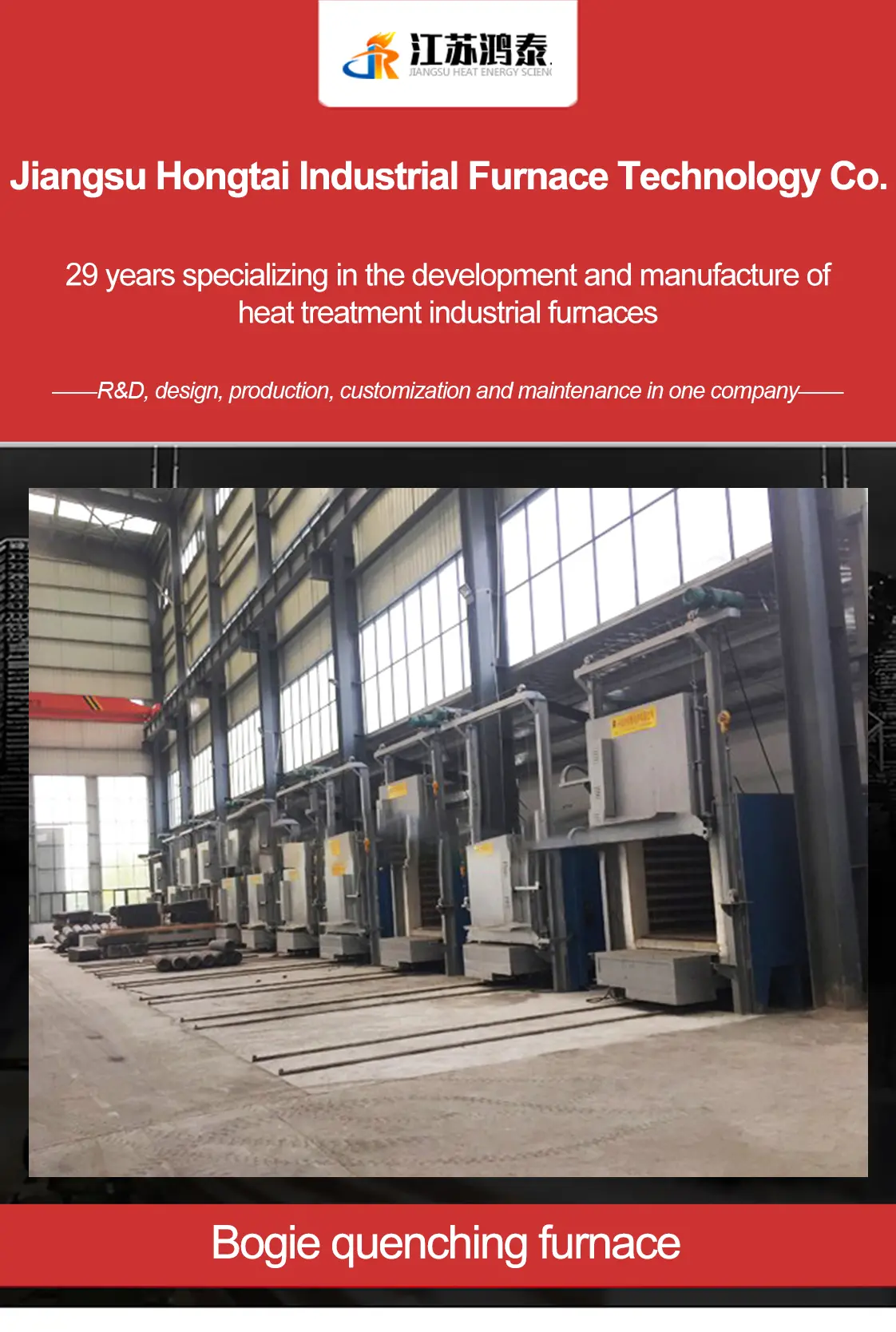
Industrial Value and Application Products
- Large Forgings: Components for power generation (turbine shafts, generator rotors), shipbuilding (propeller shafts), and heavy industrial machinery.
- Heavy Steel Plates and Sections: Used in construction, bridge building, and large vehicle manufacturing, requiring specific strength and toughness.
- Railway Components: Axles, wheels, and other parts that undergo significant stress and require high durability.
- Mining Equipment Parts: Large gears, shafts, and structural components for mining machinery, demanding extreme wear resistance and strength.
Use
The cart quenching furnace is a cycle operation type resistance furnace, mainly for die steel, hardware mold, casting parts, forging parts and other metal quenching, annealing, normalizing treatment can also be used as a sintering furnace. Used for high chromium, high manganese steel castings, ductile iron, rolls, steel balls, 45 steel, stainless steel and other quenching, annealing, aging and heat treatment of various mechanical parts.
Characteristic
The shell is welded by steel plate and steel section, the bottom of the furnace body and the cart light rail as one, the user does not need to install the foundation, only to be put on the level cement ground can be used, the furnace lining materials using ultra-lightweight 0.6g/cm3 energy-saving refractory insulation brick masonry, sandwich set aluminum silicate fiber felt heat preservation, the furnace shell and the lining of the silica-aluminum brazing sandwich filled with expansion to the stone powder heat preservation, the furnace mouth using heavy anti-collision bricks, the surface of the cart Heavy high alumina anti-pressure bricks. The electric furnace body and the cart between the labyrinth refractory masonry, but also through the self-acting sealing mechanism to reduce the heat radiation and convection loss of the electric furnace, and can improve the temperature uniformity of the furnace. This electric furnace heating element are spiral heat generator, resting on the side of the furnace shelving wire brick and cart masonry, heating element material for the international general 0Cr25AL5, element maximum operating temperature of 1200 ° C. The furnace is equipped with chromium-manganese-nitrogen (CMN) refractory material.
Trolley installed with chromium-manganese nitrogen heat-resistant steel furnace floor or 1200 ℃ silicon carbide furnace floor in order to carry the workpiece, in order to prevent the workpiece heated to produce oxidized skin through the furnace floor gap falls into the bottom of the heating element around the heating element damage, the need for frequent and regular blowing of the cart furnace floor below the oxidized skin, generally weekly blowing a blowing, blowing the bottom of the furnace analysis of the lifting, the compressed air will be the resistor wire slot in the Oxidized skin debris blowing clean.
The lift of the door of the trolley furnace is realized by rolling the wheel on the guide rail, up and down, so as to ensure the closure of the door of the furnace door masonry and the masonry of the furnace masonry between the anastomosis sealing, but also to ensure that in the process of opening the masonry will not be friction damage, the door of the furnace and the movement of the cart are by the motor through the worm gear reducer speed reducer, the chain drive to provide, and equipped with an electromagnetic brake to make the appropriate adjustments. In order to improve the furnace temperature uniformity, the furnace adopts multi-zone heating and arranges heating elements on the door and back wall for future maintenance and replacement.
